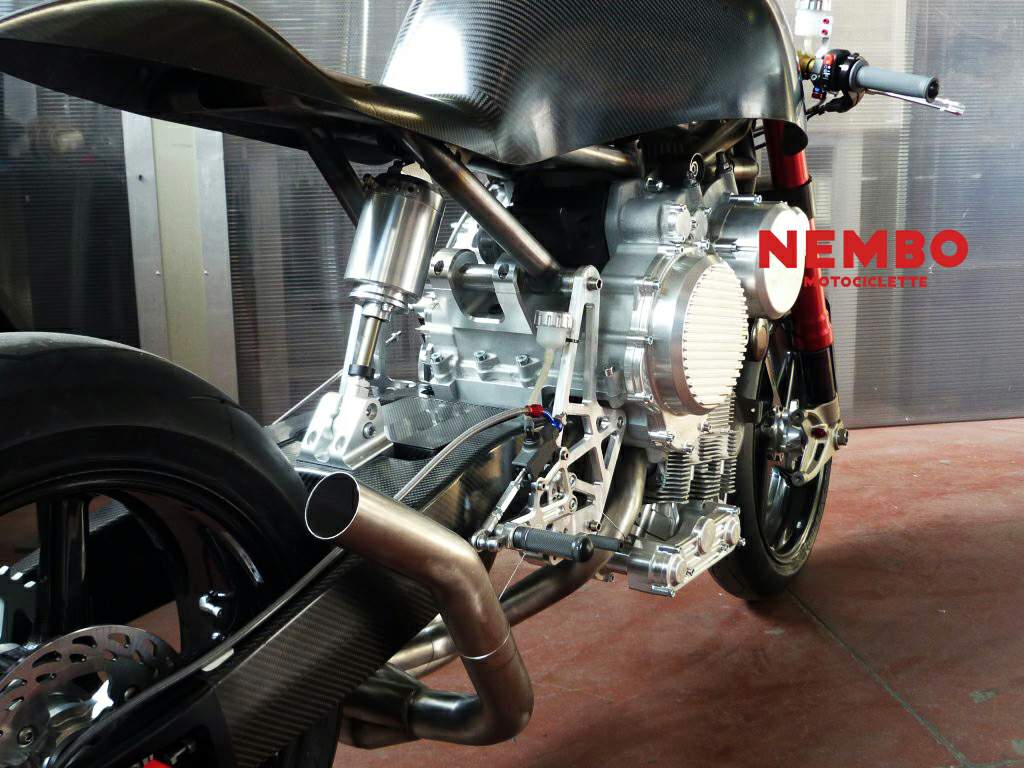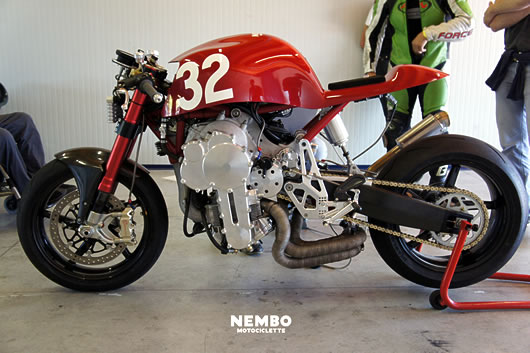
|
|
|
|
|
|
Classic Bikes
Custom Bikes
Individual
Racing Bikes AJP
AJS
Aprilia
Ariel
Avinton / Wakan
Bajaj
Benelli
Beta
Bimota
BMW
Brough Superior
BRP Cam-Am
BSA
Buell / EBR
Bultaco
Cagiva
Campagna
CCM
CF Moto
Combat Motors
Derbi
Deus
Ducati
Excelsior
GASGAS
Ghezzi Brian
Gilera
GIMA
Harley Davidson
Hero
Highland
Honda
Horex
Husaberg
Husqvarna
Hyosung
Indian
Jawa
Kawasaki
KTM
KYMCO
Laverda
Lazareth
Magni
Maico
Mash
Matchless
Mondial
Moto Guzzi
Moto Morini
MV Agusta
MZ / MuZ
NCR
Norton
NSU
Paton
Peugeot
Piaggio
Revival Cycles
Roland Sands
Royal Enfield
Sachs
Sherco
Sunbeam
Suzuki
SWM
SYM
Triumph
TVS
Ural
Velocette
Vespa
Victory
Vincent
VOR
Voxan
Vyrus
Walt Siegl
Walz
Wrenchmonkees
Wunderlich
XTR / Radical
Yamaha
Zero
Video
Technical
Complete Manufacturer List
|
Nembo Super 32 |
| . |
Why would you build a motorcycle that’s fitted with a
2000cc three-cylinder engine that’s fitted upside down? Yes, that’s right – an
inverted engine, with the cylinder heads facing the asphalt. ‘I’ve chosen this
particular engine architecture for both functional and aesthetic reasons,’ says
Daniele ‘Titus’ Sabatini, owner, project leader and chief designer of the Nembo
Super 32. ‘In current naked sportbikes, the engine is often hidden and in the
case of liquid-cooled engines, practically soulless. It pains me to see the
engine smothered under frames and plastic components. So, I thought that a good
way to use an updated air-cooled engine in a contemporary naked sportbike would
be to invert the engine!’ he adds.
Sabatini tells us that ‘inverted’ engines aren’t new and that they were used in
various combat aircraft in WWII. However, the challenge was to use such an
engine in a motorcycle, in a way that would combine form and function and that
would keep things interesting.
‘I wanted to build a high-performance big-bore motorcycle, which would look
‘new’ but which would still have a classic and timeless beauty. The bike would
have to be built with high quality metal and carbonfibre components and would be
very light,’ says Sabatini, adding that he wanted to create a bike that looked
like a proper motorcycle and not like a manga robot. Ahem.
‘Inverting the engine allowed me to achieve these results. The Super 32 is built
around the engine, where the engine, by means of a super-compact crankcase
that’s placed over the cylinders and the heads, works as the chassis, while the
heads and cylinders do not participate in structural functions in any way,’ he
says.

Sabatini claims his naturally aspirated inverted engine –
the Super 32 Rovescio – complies with Euro 3 emissions norms and can be built in
displacements ranging from 1850cc to 2100cc, with power outputs between
160-250bhp. The engine works as a fully stressed member, but the Super 32 also
utilizes steel tube trellis frame components at the front, while the swingarm is
made of carbonfibre. The bike’s dry weight ranges between 140-155kg, depending
on the materials used and options chosen.
‘The Nembo Super 32 is at its early stages of development. The first two 1814cc
prototypes are scheduled to be track tested in February 2011, after which I’ll
start producing a small series of Super 32s, fitted with a 1925cc inverted
engine,’ says Sabatini. ‘The bike is handcrafted in Italy by a highly
specialized Italian crew and only a fifth of its components (wheels, brakes,
forks and tyres) are bits that haven’t been designed and built by Nembo,’ he
adds.
According to its builder, the Super 32 is the only bike in the world fitted with
an inverted engine. ‘The bike’s architecture achieves our main goals of mass
centralization, chassis elimination, extreme lightness (considering the use of a
large displacement engine), great handling, and beauty,’ he says. And why not.
We quite agree with most of what Sabatini says, and we think his machine is
quite beautiful – not just to look at, but also as in terms of sheer innovation
and engineering.
Nembo Super 32: Tech Specs
Front Suspension: 50mm USD fork with dual-rate springs, adjustable preload,
rebound and compression damping
Rear Suspension: Air suspension system with adjustable preload and rebound and
compression damping
Brakes: Brembo, 320mm discs, four-piston radial-mount calipers (front), single
220mm disc, two-piston caliper (rear)
Engine (prototype): Four-stroke, air/oil-cooled, three-cylinder, 1814cc, SUHC,
2-valves-per-cylinder, 160bhp at 7,000rpm
Engine (production): Four-stroke, air/oil-cooled, three-cylinder, 1925cc/2097cc,
SUHC, 2-valves-per-cylinder, 200bhp/250bhp at 7,500rpm/8,000rpm
Transmission: Six-speed

|
Any corrections or more information on these motorcycles will be kindly appreciated. |